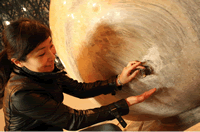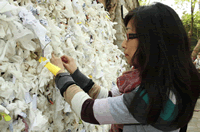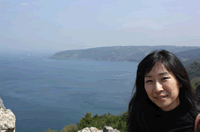acts of translation in the academy and across national boundaries
Gail E. Hawisher, Patrick W. Berry, Cynthia L. Selfe, Vanessa Rouillon, Ismael Gonzalez, and Hannah Kyung Lee
Hannah (left) with her sister Pauline and on some of their many travels together.
Click on image to see a video of Hannah doing the Rueda at the Cowboy Monkey, Champaign, IL.
-
Home
-
Introduction
-
Chapter 1: Digital Literacies, Technological Diffusion, and Globalization
-
Chapter 2: Digital Media & Transnational Connections: From Sarajevo, Bosnia-Herzegovina, and Sydney, Australia
-
Chapter 3: Cultural Designs for Writing Digitally: From Urbana, Illinois, and Afar
-
Chapter 4: Acts of Translation in the Academy and Across National Boundaries
-
Chapter 5: Global Digital Divide: From Nigeria and the People's Republic of China
-
Conclusion
-
Resources
Hannah Kyung Lee
We now introduce another coauthor, Hannah Kyung Lee, who was born in 1980 in Chicago, Illinois, in the United States, where she's spent most of her life, but who nevertheless claims a transnational identity based on her family origins in Korea and her close ties to France and the French language.
As Hannah herself explains about her life as a Korean and as an American:
"Being a second generation Korean-American, I grew up in an environment that was at times separated into two worlds. My 'inner' world consisted of home and family—the Korean side of me. Here, I spoke mostly Korean and some English with my parents. On Saturdays, I would attend Niles Korean School and learn the basics of reading and writing in Korean.
My 'outer' world consisted of school, the rest of society, and speaking English. Most of the time these two worlds remained separate, but every once in a while one would merge into the other. One of my earliest memories has to do with such a time. At the age of 5, I remember wanting to learn to read, and I would look forward to my nightly sessions with my mother as we pored over Goldilocks and the Three Bears. I remember being frustrated because I knew that I saw words on the page, yet I couldn't understand them. My mother, who had just a basic knowledge of English at the time, taught me to read English, and worked on her own English at the same time."
 |
 |
 |
 |
 |
 |
Images from Hannah's travels
Although Hannah notes that the languages of Korean and English usually marked two different spheres in her life, she is very much caught up with her mother's attempts to learn English, not unlike Gorjana and Shafinaz in earlier chapters. This sensitivity to a parent's proficiency in the language of the family's adopted home seems to be a common feature among those who claim transnational connections. It appears to be an especially strong concern for the women in the study, particularly when they talk about their mothers.
Hannah grew up with her mother, father, and younger sister and brother primarily in an area called Rogers Park, Illinois, a Chicago community known for its diversity then and now. She tells us that as a child living in what she terms "a language rich environment," she often heard, and even began to learn, languages from across the world.
"Our neighborhood library was close to Devon Street, and hearing Hindi and other Indian languages was quite common, as was Polish and Spanish. The public elementary school that I went to had French language classes for all of the students, so I started learning French in the second grade. I didn't realize that this was unusual until I moved to the suburbs—and faced the culture shock of homogenous suburbia."
She also describes her early experiences with Korean and English, and her television encounters with Spanish, like this:
"I don't remember a time when I didn't speak English or Korean. I somehow acquired both simultaneously, through osmosis. I started preschool at the age of 3—a time when children start actively acquiring language. I also remember watching a great deal of television shows like Sesame Street when I was younger, and I even managed to pick up a little bit of Spanish this way (I have a clear memory of following along and repeating the Spanish words and numbers that were presented on Sesame Street). With school and television, I was able to hone my English language skills, even though English wasn't spoken in the home when I was young."
Both Hannah's parents were born in Korea—her father on the island of Jeju-do, which is a volcanic island and now a UNESCO World Heritage site—and her mother in Namwon, where she lived on a farm. Her parents came to the United States not long before Hannah was born, with her mother easily finding a position as a registered nurse and her father eventually going on to own an architectural firm.
Visiting her father's office provided opportunities for Hannah and her sister as children to experiment with various computer applications including word processing, software packages that vendors would send her father, and America Online. She says:
"We also got to use his computer, and I remember one of the things my sister and I would do would be to take turns typing verbatim the text that was in one of the books that we were reading. I was really into the Baby-sitter's Club in the fourth grade, so it was probably one of the books in that series. It was mostly typing practice, but I remember thinking it was great fun. When I got a little older, I would use the computer to type short stories or poems of my own."
Hannah also remembers a bit later, in the early 1990s, discovering chat rooms through America Online with her sister and having conversations with people from all over the United States.
In 2006, Hannah entered the M.A. writing studies graduate program at the University of Illinois, enrolled in a graduate seminar, and, as part of that class, completed an assignment that required her to author a writing process video. Here is the video that Hannah composed:
Hannah's writing process video. Click on any image to view <transcript>.
In writing about her video, Hannah says:
"My video camera went with me wherever I went—the bus, the airport, my apartment, my mother's house. I knew that I wanted to collect a montage of my daily activities, to translate these images, sounds, and words into something that would portray the mundane, yet mind-wrenching activity that is my writing process."
She adds:
"Notions of stretched and retracted time were invoked. Time seemed to pass by without my noticing as I worked on the video—which is nothing like the dread and procrastination that usually accompanies my typical writing assignments with their ever-present deadlines looming before me. The hours it took to get the various shots of me typing at my computer amount to a few moments in the video. Yet the repetitive, insistent cuts evoke the feeling of stretched time.
Quickly paced cuts of the activities that I engage in while not writing—checking my e-mail, going for a walk, getting a drink of water—push their way into my writing process and keep me from it, all the while engaging with it, briskly furthering the process along."
In many respects, Hannah's video begins to illustrate what Elaine Chin (1994) has written about writing and its production. Chin argues:
"The context for writing always includes the material conditions, the time and space writers occupy as they write, as well as the web of social interactions affecting composing. But more importantly, the context for the production of writing needs to be conceptualized as the writer in situ in that it is the social text that writers create for themselves and in which they situate themselves." (Chin, 1994, p. 476).
And here, with the video, it is Hannah doing the conceptualization, not necessarily a researcher looking on. What we perhaps see less of in this particular video of Hannah's are ostensible traces of how family histories and cultural customs are folded into her everyday literacies. In the absence of more background on her literate life and the cultural ecology of digital literacies (Selfe & Hawisher, 2004) in which she immerses herself daily, lots is elided in Hannah's rich story of her literate activity (Prior, 1998).
But through online alphabetic writing—through e-mail—Hannah has told us something additional about the joys of transnational ties, of visiting family in Korea and reconnecting with aunts, uncles, cousins, and grandparents:
"I visited Korea for the second time in my life the summer of 1999, and reconnecting with my family and heritage made me realize that while I had gained much by growing up in the U.S., there were certain things I had lost as well. I had missed out on what it means to have aunts and uncles around me to talk to, cousins to grow up with, grandparents to tell me stories, and a profound sense of shared identity, culture, rootedness, and place. In the Korean language, when referring to Korea, people say 'uri nara'—'our country.' There is a deep linkage between language, culture, place, and blood that I experienced for the first time that summer of 1999. I remember walking through the streets of Seoul and feeling the novelty of blending into the crowd—what a strange sensation it was to look like everyone else and not stick out! It was something that I could get used to very quickly. I felt an immediate connection to all of my relatives—even though I barely knew most of them. From the moment I was with them, thoughts of being a foreigner or outsider were brushed aside (although they would surface now and again). There was a kinship connection that went very deep, to a place that's difficult to describe in words. An aunt tried to articulate it by saying that even though I was an American citizen, in Korea I was Korean. The blood that ran through my veins was the same as hers. And the Korean language that I grew up speaking connected us even further".
At the same time, however, Hannah also recognizes the difficulties of being a second-generation American and the impact of this identity on language and communication. She writes:
"I never really thought about the communication barriers I've had to grow up with, [and while visiting Seoul] in many ways it felt good to go back to my roots. Yet, as I visited cousins and aunts and uncles and grandparents that I never knew, and tried to communicate with them in the Korean that I had managed not to forget over the years, I noticed for the first time just how different my experiences were from those of my cousins. I marveled at how easily they communicated with my aunts and uncles and how perfectly they understood one another. My cousins didn't have to tone down or change their words so that their parents could understand. They simply spoke."
And Hannah has said more about communication difficulties. She has noted, for example, in a literacy narrative video that she contributed through the Digital Archive of Literacy Narratives (DALN), that communicating with her mother in this country is also sometimes a challenge.
Hannah's DALN video interview <transcript>
Here, Hannah describes her role as a translator, as a mediator, in helping her mother negotiate day-to-day literacies in an environment where some make the mistake of thinking her mother uneducated because they themselves don't recognize her fluency and expertise in Korean—a language in which she writes poems and essays that they cannot understand. Regardless of others' parochialism, however, this role as mediator—what Louie (2009) describes as children serving as "language and cultural brokers" who are asked "to interpret the world of mainstream America" (p. 40)—often becomes an additional responsibility of children whose parents were born elsewhere. Hannah reminds us, too, that while those with transnational connections tell of shared experiences—problems with communication, for example—there are also complexities, like her mother's hearing loss, that amplify the individual problems at hand. We should note, however, that Hannah is also fluent in French and has used this language to understand more fully the different roles available to her in different languages. Remember the French she started learning in the second grade? Just as Ismael persisted with English from the third or fourth grade on, Hannah persisted with French, taught to her in Chicago first by a teacher who hailed from Haiti and then by a teacher from Lithuania. Of some of her experiences with French, Hannah writes:
"I really began to become interested in the French language and in France in seventh grade. My teacher was born in Lithuania and had escaped the Nazis in World War II. I think she spent some time in France as a result. She was a wonderful storyteller, and I would always look forward to French class. I also loved the cultural tidbits that she'd offer—about the hours that she'd spend around the dinner table in France, about how French people shopped and bought groceries, about how Paris was spared during WWII because even though Hitler ordered it to be burned, a German general refused to destroy the most beautiful city in the world."
Eventually, while an undergraduate, Hannah participated one summer in a language-immersion program in Avignon, France, and loved the experience. As she says:
"Nothing could have prepared me for the beauty of Provence or the wonders of living with a French family. I was hooked."
After graduating from the university and spending a difficult year teaching high school in inner-city Chicago, she secured through the French ministry a teaching position in Paris and, while there, went on to earn a diploma in French (Diplôme approfondi de la langue française C1). When Hannah entered the University of Illinois's writing studies program after teaching for two years in Paris, she was recruited through cell phone conversations connecting Paris to Urbana, Illinois, and even during vacation time in Hilton Head, South Carolina. Advances in mobile technology continue to abet communication across borders, providing increasing opportunities for students with transnational connections.
During all this time, Hannah's experiences, along with Vanessa's and Ismael's, were increasingly shaped by this rapid expansion of digital communication technologies. Hannah began blogging about her life and experiences while in France. Like Ismael, she is an active participant on Facebook, where she maintains connections with and keeps connected with those whom she met while working in Paris. She notes that "transnationality" seems to be a common feature among her friends there:
"There's Grace Mutebele, who was born in the Congo, Africa, raised in Brussels, Belgium, and was studying abroad in Paris when I first met her. She speaks about seven or eight languages fluently (French, English, Spanish, Flemish, Lingala, Swahili, and some Japanese; there might be others). There's Grace Manurung, whose Indonesian parents immigrated to Cologne, Germany in the 1970s, where she was born. She went to high school at a boarding school in the United Kingdom and went to college at Andrews University in Michigan. She's taught English in various places, including Thailand and Hong Kong, and currently lives in London, where she works for a media company. There's Anne-Marie Nguyen, who is of Vietnamese ethnicity and was born in Paris. She's studied and lived all over the world, including New York and Madrid. She currently lives and works in Munich, Germany. There's Imelda Hertono, a fifth generation Chinese in Indonesia, whose parents sent her to live in Singapore with an aunt when she was nine years old so that she could become fluent in English. When I met her, she had been studying and working in Paris for a couple of years. We both left Paris around the same time—I went back to the States while she went back to Singapore. While there, she met her French husband-to-be at a trade conference, got married, and they now currently live near Liege, Belgium. And finally there's Cedric, an African American who taught English in Korea for a year and knows how to speak, read, and write the language. He's back in the States, working in Baltimore, Maryland. Because we all have French and English as our shared language, it's very common for us to switch back and forth between the two languages. Code switching is a fact of life for me, and I think nothing of it—but I guess we're quite a sight when we all get together. A friend of mine joked that we were like a United Nations of friends. I guess I never thought about it like that before, but he has a point! Because of technology, we've been able to keep in contact fairly easily and regularly. Facebook is a given, as well as e-mail. Skype has been a lifesaver for us. When looking at the time, I sometimes automatically convert the time to French/German/UK time, especially if I'm expecting a call."
With over 400 friends on Facebook, Hannah moves easily back and forth between languages, technologies, and places. A Facebook posting invited any of these friends to meet up with her in Los Angeles, where she was traveling to from Chicago for a weekend.
Hannah, like other individuals in this study, begins to balance an understanding of global trends—the increasing reach and scope of expanded digital networks—with her own local sense of place and language, identifying the specific historical, political, and social factors that influence the use and availability of digital technologies in various spaces and at various times. We have become increasingly convinced, along with Carmen Luke (2006), that experienced educators can learn a great deal from graduate students like Vanessa, Ismael, and Hannah. In particular, we can explore and come to know more about the increasingly complex and extended global landscapes that many in our classrooms and institutions now inhabit. And, as we explore these landscapes, we can also take up the responsibility of creating curricula that "facilitate spaces and practices of cultural complexity, complex connectivity, and difference," helping all students develop the "capacity to understand and negotiate identity in a global setting, where national differences remain salient but are inflected by a range of other elements" (Luke, 2006, p. 115). Within globalized educational environments, we believe that the critical use and study of digital networks and media should also assume a major role. Certainly the observation of how people make use of and thus transform extended technological environments, the digital tools of human communication—and the multiple languages they deploy in those environments—can help us understand a great deal about the changing transnational landscapes that dramatically influence our lives and the lives of those with whom we live and from whom we learn.


